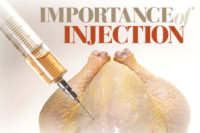Leveraging optimal technologies is perhaps the key variable in the operation of a successful precooked or smoked meats system. Processors with the most efficient and effective ovens and smokehouses are positioned to develop meats with superior flavor and texture that meet food safety standards.
Injecting solutions into meats can be both beneficial and troublesome for producers.
While liquids including marinades and brines can enhance the flavor of products and enable retailers to generate greater revenues from value-added and tastier proteins, solutions also can trigger food safety issues.
Two major concerns are the prospect of transferring pathogens present on the exterior of cuts to the interior during the injection process, and recirculating contaminated liquids into products. Keeping injection machinery free of pathogens also is a problem.
While steps are being taken to decrease such threats, they remain ever-present dangers.
“There is risk from taking what is on the outside of meats and moving it to the inside,” says Douglas Powell, a Brisbane, Australia-based food safety consultant and former professor of food safety at Kansas State University. “And it is scary for the consumer when there are outbreaks from doing so.”
Bacteria driven into the center of meats when marinades are injected, for instance, can be harmful to consumers if the cuts are not cooked adequately to kill the microbials. Rafael Rivera, manager of food safety and production programs for the Tucker, Ga.-based U.S. Poultry and Egg Association, says incidents can occur when proteins such as beef and pork are cooked at rare or medium temperatures.
In response, some producers spray organic acid onto the surface of meats prior to injection or tenderizing to kill pathogens.
Dealing with the unexpected
The use of solutions that are designed to keep meats tasty also can bring unanticipated consequences.
Recirculating solutions among pieces of meat, for instance, can cause problems if the brine isn’t properly filtered, says Lynn Knipe, extension processed meat specialist at Ohio State University. Meat particles and ingredients, such as starches and soy proteins, can plug needles and prevent uniform injection. Foamy brines also can affect the appearance of products if the foam gets drawn into the injector.
Rivera recommends keeping such solutions below 40 degrees Fahrenheit to help prevent recirculated liquids from carrying pathogens before being reused.
Jeff Sindelar, associate professor and extension meat specialist at the University of Wisconsin, agrees recirculation can be risky.
“Some manufacturers as a practice won’t recirculate solutions, but it is difficult not to have some level of recirculation occurring through the injection process,” he says. “It is difficult to totally prevent cross-contamination, but the goal is to minimize it.”
To diminish incidents, processors also need to closely scrutinize their injecting equipment for possible sources of pathogens.
“It is important to have a good operational sanitation program that includes cleaning the difficult to access areas on machines, such as hoses, pipes and needles,” Rivera says.
Knipe adds that for plant safety, processors need to avoid flushing large quantities of phosphates and chlorides (from salt) down their drains.
Cleanliness is key
Meat producers should have a plan for sanitizing both the outside and inside of equipment, Rivera says, adding that the likelihood of contamination often hinges on the type of ingredients being injected.
Solutions with higher salt content, for instance, typically increase the microbial count on equipment.
Rivera says it also is crucial for injection needles to remain sanitized. That, however, is difficult when the needles are situated inside machinery.
Sanitizing methods that have proven effective include using ultra-sound pressurized air to clean the inside of the apparatus, he says. Pipes and hoses also should be removed and cleaned internally to eliminate the threat of bacteria buildup from marinades.
“Solutions can form a glaze that accumulates, causing bacteria to form,” Rivera says. “Spoilage bacteria will affect the shelf life of meat.”
Sindelar says newer generations of injecting equipment are becoming easier to sanitize. Some models, for instance, contain fewer movable parts with fewer crevices for bacteria to form.
Designs also allow for the continuous sterilization of needles. Needles in such systems are covered with anti-microbial solutions during the injection process.
Eye on the prize
To further enhance food safety, Rivera says producers should have procedures for locating materials that can be embedded in meat during the injection process. Methods include visual inspections and using metal detectors to spotlight needles that occasionally break off from machines.
In addition to solid food safety protocols, an effective injection operation also enables the optimal amount of solution to be added to proteins.
A challenge for processors, Knipe says, is to maintain higher injection levels without causing product defects. While some processors leverage faster, higher-pressure injections, he notes the procedure can result in damage to meats, such as pickle pockets and unequal distribution of the brine.
An alternative, he says, is to have two injector heads pumping solutions simultaneously, at lower pressures into the meat. Smaller processors can accomplish the same result by passing meat pieces twice through a traditional single-head injector.
Accomplishing lower injection pressures with a larger number of smaller needles, which streamlines the operation, is optimal, he says.
“It allows producers to get a greater amount of solution into the product without using high injection pressures,” Knipe says.
Education is the answer
While evolving technologies and operating systems are strengthening the injection process, it also is important for consumers to be versed on the procedures of food safety for it to be maximized, Powell says.
He says, for instance, meat packages should contain labels that notify shoppers the products were needle tenderized and state the recommended temperature for cooking.
Powell says retailers and producers should voluntarily provide such data in the absence of government mandates. The U.S. Department of Agriculture, however, has proposed legislation that would require mechanically tenderized beef to be labeled and feature cooking instructions.
“The best companies will get out ahead of any potential legislation, Powell says. “Retailers should tell their customers what is in their food. Those are the companies I want to reward with my business. Most retailers, however, don’t want to show any sign that some food might be unsafe, even though consumers read about outbreaks every week.”
Notifications already occur in Canada. In 2014, the Canadian Food Inspection Agency began requiring labels to identify mechanically tenderized beef. It defines such items as uncooked, solid cut beef that has been pierced by blades, needles or other similar instruments, or the beef has been injected with a marinade or other tenderizing solution.
The label, in both English and French, also must also state the meat should be cooked to a minimum internal temperature of 63 degree Celsius (145 degrees Fahrenheit). In addition, labels on steaks must instruct users to turn the meat over a least twice during cooking to help achieve a consistent temperature throughout the product.
Powell says labeling proteins that have been mechanically injected — or even providing such information to consumers via quick response codes or directing them to a Web site — will eliminate the need for shoppers to seek information from retail associates, many of whom are unfamiliar with the process.
“You don’t want a kid working at a supermarket to be your critical point for the transfer of information on the safety of your product,” he says. “Consumers are getting smart and information is becoming more transparent. Merchandisers will have to fall in line eventually. The best ones will go in front and not wait to be pushed.”
While equipment manufacturers, processors and government agencies are addressing concerns by launching new technologies, procedures and mandates, it is the consumer who will ultimately judge the attractiveness of the products.






Report Abusive Comment